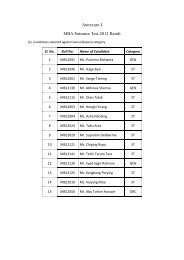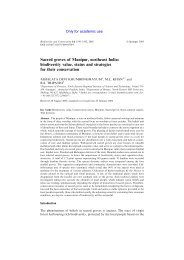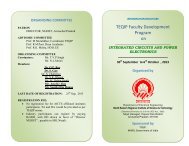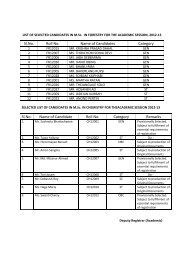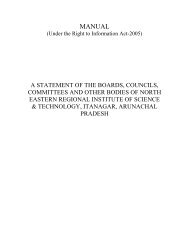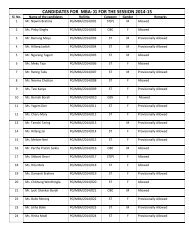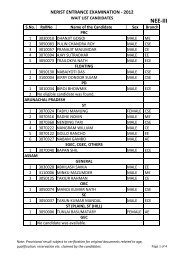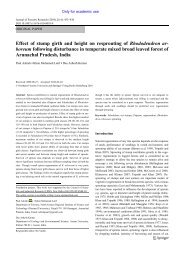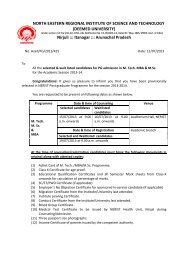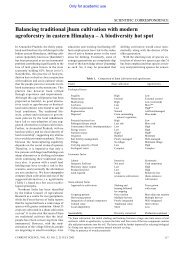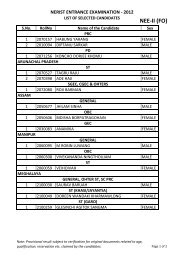Clerodendrum colebrookianum Walp. A potential folk ... - NERIST
Clerodendrum colebrookianum Walp. A potential folk ... - NERIST
Clerodendrum colebrookianum Walp. A potential folk ... - NERIST
You also want an ePaper? Increase the reach of your titles
YUMPU automatically turns print PDFs into web optimized ePapers that Google loves.
Asian J Pharm Biol Res |Oct-Dec 2012 | Vol-2 | Issue-4<br />
India (BSI) Itanagar, Arunachal Pradesh were also consulted for<br />
validation of identifications. The specimens are deposited in the<br />
Herbarium of Forestry Department, <strong>NERIST</strong>, Arunachal Pradesh<br />
for further research work.<br />
It has been found that the species is known by 33 different<br />
vernacular names by the 35 tribal communities of north eastern<br />
region of India (Table 2). The species is widely used by 20<br />
different tribes of six states of North East India for the treatment<br />
of hypertension (Table 3). Of the plant parts, leaf was used in<br />
majority of cases. In addition to hypertension, the species have<br />
also been used against other ailments like diabetes, blood<br />
purification, abdominal pain, diarrhoea, dysentery, heart trouble,<br />
cough etc. (Table 4). However, majority of tribal communities of<br />
north eastern states used the species against hypertension (Figure<br />
2). Preparations were found to be used in the form of decoction,<br />
juice, leaf extract, raw, soup, boiled, infusion etc. The present<br />
study also reveals that use of the plant as a home remedy for the<br />
treatment of hypertension is not confined to a particular group of<br />
ethnic tribe or a particular community but it is widely used by a<br />
large number of tribal communities belonging to different states<br />
of north eastern region of India.<br />
The chemical constituent of C. <strong>colebrookianum</strong> shows<br />
the presence of phenols, alkaloids, flavonoids, polyphenols,<br />
[1]<br />
steroids etc. . Furthermore, GC MS analysis of C.<br />
<strong>colebrookianum</strong> hexane extract shows the presence of 28<br />
[8]<br />
compounds . Five new steroids, colebrin A-E were also isolated<br />
[9]<br />
from the aerial parts of the species . Moreover, presence of β-<br />
sitosterol and sterol compounds in the leaves of C.<br />
[10, 11]<br />
<strong>colebrookianum</strong> has already been reported (Figure 3). β-<br />
sitosterol, a bioactive phytoconstituent that decrease the serum<br />
cholesterol and also have cardio protective <strong>potential</strong>ity which is<br />
a valid scientific basis for consuming it for better health in north<br />
[12]<br />
east region of India . Earlier it had been indicated a beta<br />
blocking effect on toads and dogs and a gradual fall of blood<br />
[5]<br />
pressure within humans . Antihypertensive property of C.<br />
<strong>colebrookianum</strong> has been reported from the leaf extract of the<br />
[13]<br />
species . It has been reported that C. <strong>colebrookianum</strong> extract<br />
has role in ameliorating experimentally induced insulin<br />
resistance and hypertension and provides the first<br />
pharmacological evidence for protective role of C.<br />
<strong>colebrookianum</strong> leaf against experimentally induced metabolic<br />
[8]<br />
syndrome .<br />
The pharmacological study of C. <strong>colebrookianum</strong><br />
indicates the immense <strong>potential</strong> for the treatment of diabetes and<br />
hypertension. But still, the full <strong>potential</strong> of C. <strong>colebrookianum</strong><br />
has not been explored. Most of the research has been in vivo and<br />
helped validate the applicability on the human system. In vitro<br />
studies could have facilitated a better understanding the mode of<br />
action of C. <strong>colebrookianum</strong>.<br />
The current research also shows leaves are used<br />
extensively for medicinal purposes. Moreover, there has not been<br />
any report regarding cultivation of the species by the local<br />
people. This is one of the major concerns for the sustainable<br />
utilization and conservation because of over harvesting from the<br />
wild which may lead to depletion of the population or extinction<br />
of the species particularly from its habitat. In addition,<br />
anthropogenic disturbances may lead the degradation of the<br />
species from natural habitats. Thus, there is an urgent need for<br />
exploration, documentation, identification and prioritization of<br />
important medicinal plant species.<br />
CONCLUSION<br />
The information from the present study needs thorough<br />
phytochemical investigation along with clinical trials. In Silico<br />
screening of the biochemical compounds and metabolites may<br />
lead to finding or predicting <strong>potential</strong> drug candidates against life<br />
threatening diseases and other bioactive compounds of other uses.<br />
Development of database, proper harvesting and cultivation<br />
techniques and also awareness programs in the state as well as<br />
region level for the conservation and management of <strong>potential</strong><br />
species are utmost important.<br />
ACKNOWLEDGMENT<br />
The authors are grateful Dr. A. A. Mao, Joint Director,<br />
Botanical Survey of India, Arunachal Pradesh for identification of<br />
<strong>Clerodendrum</strong> species. The authors thank local guides and<br />
villagers for cooperation and support during the field work.<br />
REFERENCES<br />
1. Shrivastava N, Patel T: <strong>Clerodendrum</strong> and Healthcare: An<br />
overview. Medicinal Aromatic Plant Sci. Biotech., 2007a,<br />
1(1): 142-150.<br />
2. Srivastava RC, Choudhary RK: Species diversity and<br />
Economic importance of the family Verbenaceae in<br />
Arunachal Pradesh. Bull. Arun. Prad. Res., 2008, 24(1&2):<br />
1-21.<br />
3. Bhuyan LR: Some plants used as medicines by the Nishi<br />
tribe of Arunachal Pradesh: A preliminary study. J. Econ.<br />
Taxon. Bot. 2003, 27(2): 447-450.<br />
4. Buragohain J: Ethnomedicinal Plants Used by the ethnic<br />
Communities of Tinsukia District of Assam, India. Recent<br />
Res. Sci. Tech., 2011, 3(9): 31-42.<br />
5. Nath SC, Bordoloi DN: <strong>Clerodendrum</strong> <strong>colebrookianum</strong>, a<br />
Folk Remedy for the Treatment of Hypertension in<br />
Northeastern India. Pharmaceu. Biol., 1991, 29(2): 127-<br />
129.<br />
6. Bordoloi B, Borthakur SK: Botanical identity of “Phuinum”<br />
a <strong>folk</strong> remedy for hypertension. Bull med-ethno. Bot. Res.,<br />
CCRAS, New Delhi, 1997, 18(1/2): 18-29.<br />
7. Hooker JD: Flora of British India. L. Reeve and Co. Ltd,<br />
Kent. 1885, IV: 589-596.<br />
8. Jadeja RN, Thounaojam MC, Ramani UV, Devkar RV,<br />
Ramachandran A: Anti-obesity <strong>potential</strong> of Clerodendron<br />
glandulosum Coleb. leaf aqueous extract. J.<br />
Ethnopharmacol., 2011, 135(2): 338-343.<br />
9. Yang H, Wang J, Hou AJ, Gou YP, Lin ZW, Sun HD: New<br />
steroids from <strong>Clerodendrum</strong> <strong>colebrookianum</strong>. Fitoterapia,<br />
2000, 71(6): 641-648.<br />
10. Jacke G, Rimpler H: Distribution of iridoid glycosides in<br />
<strong>Clerodendrum</strong> species. Phytochemistry, 1983, 22(8): 1729-<br />
1734.<br />
11. Goswami P, Kotoky J, Chern Z, Lu Y: A sterol glycoside from<br />
leaves of Clerodendron <strong>colebrookianum</strong>. Phytochemistry,<br />
1995, 41(1): 279-281.<br />
12. Devi R, Sharma DK: Hypolipidemic effect of different<br />
extracts of Clerodendron <strong>colebrookianum</strong> <strong>Walp</strong>. in normal<br />
and high-fat diet fed rats. J. Ethnopharmacol., 2004, 90(1):<br />
63-68.<br />
260



